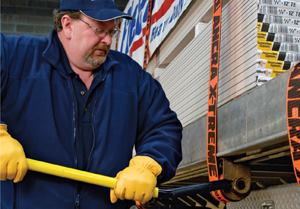As assistant superintendent for safety and training, Osborne is responsible for protecting the load, the transporting vehicle, and the motoring public by ensuring loads stay put during transport. “Training is one of my most important duties,” he says.
The county's contracted manufacturers and their vendors typically conduct training courses for operators, mechanics, and technicians at county facilities, but occasionally Osborne sends staff offsite for specialized training opportunities.
“We incorporate the best resources and management practices we can find nationwide — not just what's available in our backyard,” says Osborne. But he has an excellent resource right next door in Arlington, where the
American Trucking Associations (ATA) and its Technology and Maintenance Council (
TMC) are headquartered.
The
TMC produces training materials, such as its
Recommended Practices Manual, which reflects best management practices for vehicle maintenance and operations.
RP 739, “Maintenance, Inspection, and Operating Guidelines for Cargo Securement Systems Used on Flatbed Vehicles” supplements Federal Motor Carrier Safety Association regulations.
What to inspect when you're inspecting While the federal regulations spell out what needs to be done,
TMC's guidelines explain what to look for when doing it — including securing the devices as well as all anchor points and hardware used to attach them to a vehicle. The most commonly used tie-down materials are chains, straps, webbing, pipe or roll wedges, and wire or synthetic rope. The guidelines assume proper sizes and types of devices are used, with appropriate working loads.
Much attention is given to tracks and mounting assemblies for tie-downs and cargo restraints. Operators should inspect tracks for sliding winches and railings to assure they are securely fastened, and are free of cracks and structural damage. All tracks should have positive stops on the ends to keep them from falling off.
Winch inspection should include welds and mounting devices that hold winches onto rails. Check winch mechanisms for deformed mandrels, bent or broken ratchet teeth, and bent pawls that could cause a sudden release while under loads. Also inspect ratchet tie-downs for web straps, and look for cracked or deformed frames, damaged or missing pawls, ratchet teeth, and handle release cams. Hook ends should not be damaged or deformed. Web ratchet assemblies should show no deformation. All anchor bolts should extend through their lock nuts by at least 1½ threads. If equipped for cotter pins, the pins should be present and bent 100 degrees apart.
Check webbing to ensure there are no deep cuts or burns, and that wear and abrasion are minimal. Webbing ends should be seared at free ends to prevent fraying, and hooks should not show damage or excessive wear.
Along with webbing, chains are most frequently used to secure platform loads, from vehicles to boulders. Inspection should assure that no links are stretched. Hook throat openings should not be bent or in any way deformed, either by wear or damage. If any problems are found, remove chains from service — do not attempt to repair them.
TRAINING REGULATIONS Training for securing loads is based on Federal Motor Carrier Safety Administration (
FMCSA) regulations, specifically in Title 49 of the Code of Federal Regulations, Subpart I — Protection Against Shifting and Falling Cargo, Sections 393.100 through 393.136. The guidelines can also be found in the Pocketbook given to all commercial drivers-license holders, equipment operators, and maintenance professionals.
Chain binders should have hooks, hook eyes, end swivels, links, handles, and frames checked. Throat openings should not be bent or deformed. As with chains, never attempt to straighten anything on a binder. Replace them instead.
Inspecting wire rope focuses largely on broken strands. Six broken strands per lay (one full turn of a strand around the core), or three broken wires in the same strand, are enough to take the rope out of service. Wire rope with a broken core or a severe kink should be discarded. Never try to straighten kinked rope.
TMC recommends spraying serviceable wire ropes with cable spray to eliminate internal friction and lubricate the core. Or, brush on a 50/50 mix of SAE 30 nondetergent motor oil and kerosene and allow it to drip clean.
Synthetic rope should also be checked for cuts, abrasions, and broken strands. Once checked for damage, ensure all cargo securement devices are operable.
“Cargo securement is not new technology — the practices have been developed and refined over years,” says Osborne. “We've avoided problems by using proven management and maintenance practices.” Their record speaks for itself: Fairfax has earned multiple safety and environmental stewardship awards from the State of Virginia.
— By Mr. Paul Abelson, the former director of the Technology and Maintenance Council (TMC) of the American Trucking Associations, a board member of Truck Writers of North America, and active in the Society of Automotive Engineers.
— If there is any violation on the copyright, please contact us for delete, Thank you.
— Wristrong China knows the standard and regulation for the lashing tie down system in United States very well.
well, Here are our US Standard and Regulated Flatbed Lashing tie-down systems for your choice.




